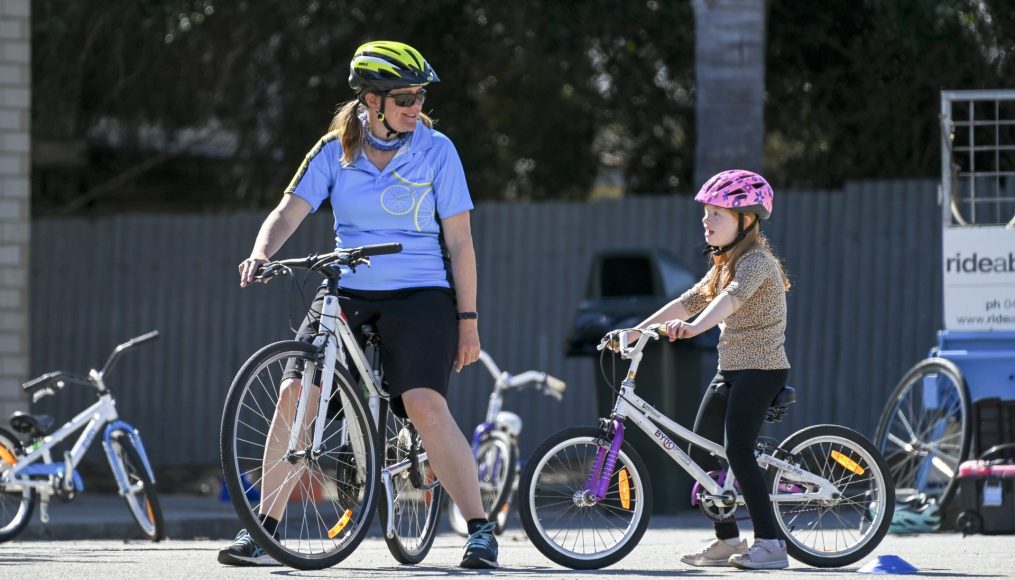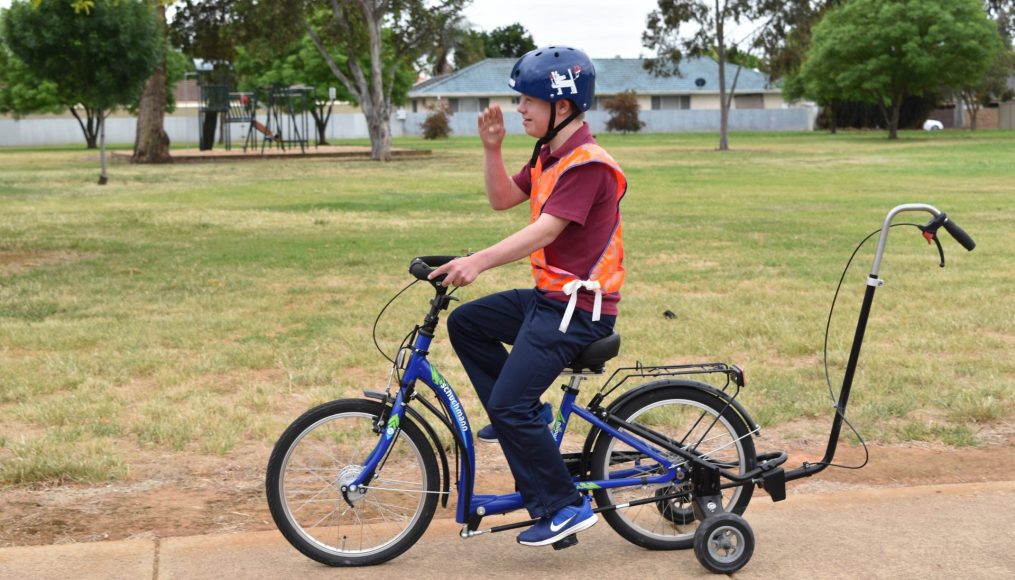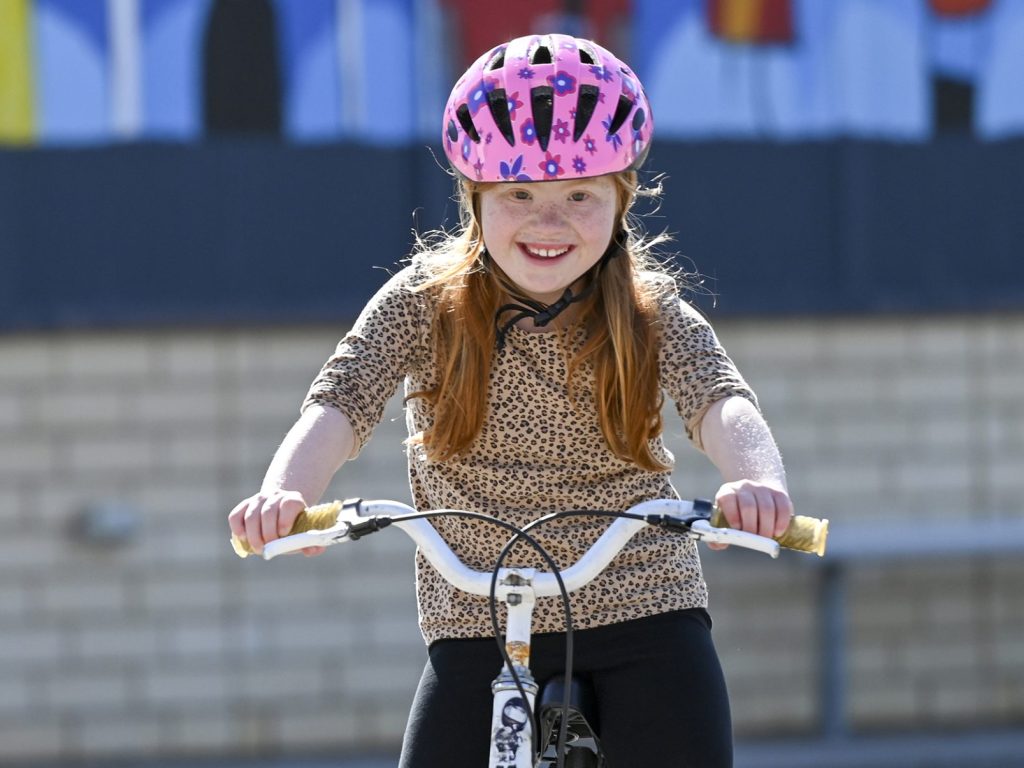
As a mother in the midst of taking off the training wheels, Rebecca Richardson knows that patience is the key to success when it comes to her daughter Aurelia taking flight along the footpath.
“You’ve always got to have patience in these situations,” Rebecca says. “That’s definitely the case with bike riding, as with all life skill kids have to learn. It takes time.”
From the age of four Aurelia has tried to learn riding on everything from a wishbone bike to a tricycle, a three-wheeled body cycle bike, to a traditional bike with training wheels. Rebecca always held the hope Aurelia would graduate to two wheels, and now that her daughter is nine she has found support with Ride-A-Bike Right.
Lee-Anne Fleming, owner and lead coach of Ride-a-Bike Right in Adelaide has taught people with Down syndrome to ride a bike at every age – from young children to older adults in their 50s.
She says the most important thing to remember is that all people are individuals and learn at their own level.
“One of the key things is to break the levels of progression down into smaller steps,” Lee-Anne says.
“For example, most neurotypical children might learn to get the glide motion in two to three progressive steps, however children with Down syndrome might need a few more levels of attainment such as seven or eight smaller progressive steps to reach that level.”
Lee-Anne says anyone young or old learning to ride a bike has to get into a state of flow, so they are moving naturally.
However, if they are resistant to activities that involve speed, such as going on swings or slides at the playground, they might be more cautious and have a difficult time learning the skills to ride a bike.
“If they don’t love on being on slides or swings, that’s their bodies saying that the speeds are too much for their bodies to handle,” Lee-Anne explains.
“Speed is important in bike riding, because if you don’t have the power to create the momentum to create the speed, they can find it harder to learn balance.”
Practice, practice, and practice some more
Like all new skills, practice makes perfect.
“For a lot of children, it’s getting in that regular practice and trying for five minutes, by going down the driveway and back again. That can make a big difference,” Lee-Anne says.
“If they don’t practice their new skills, they will be going back a step. Make the commitment and follow through.”
Rebecca says with Aurelia, she’s in it for the long game.
“We’ve been practicing and she’s definitely building up her confidence,” she says.
“I do think confidence is a big barrier. Once she does get something though she’s over the moon.”
While bike riding might not be an essential life skill for everyone to learn, it contributes to many on-going benefits for kids and adults alike.
“If your child really doesn’t want to do it, you can’t force them to do it. It’s not an essential skill for life,” Rebecca says.
“But being an OT myself, I can just see the benefits on an individual level. It’s not only about the skill of riding a bike, but also about core strength, posture, bilateral coordination and a willingness to achieve something. That’s why we’re doing it.”
Using the right bike
Bike choice is a big consideration to make.
“It’s really important that they have the right bike to learn on,” Lee-Anne says.
“The bike shop will sell you a bike, but it might not be the right bike for them to learn on as it might be too big and heavy.”
She suggests doing some research about what bike to get, otherwise you could be out of pocket for a lot of money. Lee-Anne says to remember that a good quality bike will last longer.
“The strength of the child is really important when learning, particularly if they’ve got low muscle tone. From my experience, when the bicycle is too heavy it makes it so much harder to learn to manipulate it.”
“So having a bike relative to the child’s size and strength is key.”
Lee-Anne says some people with Down syndrome or their families might make the choice to have a tricycle or adapted bike, as this is one less worry for them.
The benefits of bike riding
- Regular cycling contributes to good physical health – not only is it a good cardio work out, you also build muscle around the glutes, hamstrings, quads, and calves.
- Having fun outside with others and being active has a positive effect on your mental health.
- Committing to learning a skill improves your confidence when you get closer to your goals and are achieving new things.
Adapted bikes
When James from Kyabram grew out of his toddler bike and was unable to be supported by the standard training wheels on a larger bike, his mum Margie began to research bike modifications and adapted bikes.
“A friend at the time lent us their modified bike. It was a standard bike with large training wheels on it, which helped stabilise the size of the bike,” Margie says.
“However, James still struggled to get his leg over the frame.”
So she began the process of getting quotes for bike adaptions, reports from James’ occupational therapist to outline his needs, and visiting Mobility Plus to determine specifications (including a wider seat for core stability and a steering wheel instead of t-bar) in order to complete the NDIS paperwork to apply for funding.
The entire process took two years, but now 14-year-old James has his adapted bike and loves it. He can get on it himself, he is learning how to brake, and the bike also has a steer and break control via a handle at the back so Margie can support him as he builds his confidence levels.
The biggest challenge James and Margie now face is finding somewhere safe, flat and suitable to practice.
Margie says that although an adapted bike is expensive and the process of applying for funding through the NDIS can be long and frustrating at times, she believes that “every child has a right to ride a bike.”

Advice to families
Rebecca says if parents are thinking of getting their kids into lessons, she would encourage it.
“They’ll often listen to a third person over their own parents. I think there are certain things where my daughter will respond better to a teacher in teaching mode,” she says.
“We can supplement that teaching at home with lessons in between. That helps the process because kids can get frustrated.”
She says the most important thing to do is persevere.
“If they haven’t picked it up in a month or two, don’t give up. They will get there. It will just take a bit longer,” Rebecca says.
And above all she says, have fun with it.
“It can be easy to get frustrated, but it all comes back to having fun. If we show a bit of excitement, she does too and gets better as a result.”
“It’s one of those skills that when they get the sense of elation and freedom, it’s amazing.”
The top three tips for learners
1 Buy a bike that is light weight for the learner to ride – heavy bikes can be difficult to manoeuvre around.
2 Break everything down into smaller steps: balancing, gliding, stopping etc.
3 Practice as much as possible, and don’t give up when things get tough.
This article is available in the following formats to download:


0 Comments